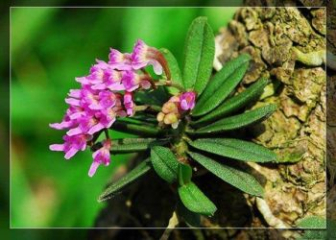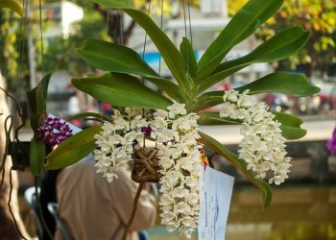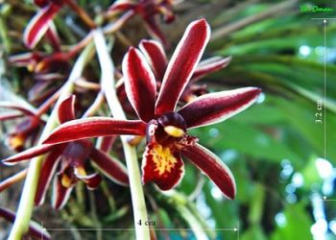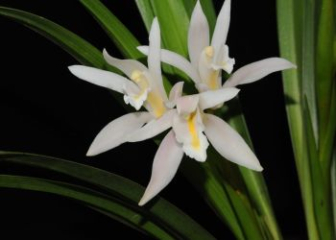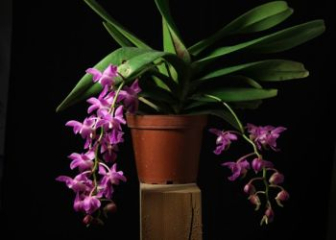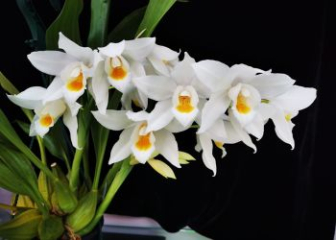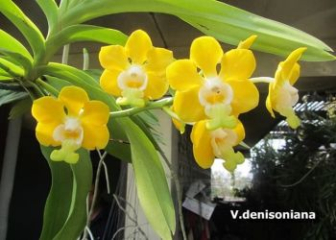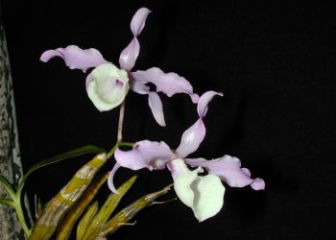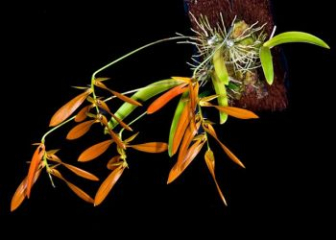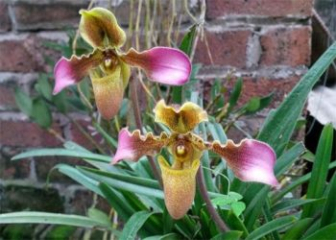Dendrobium chrysotoxum - Effective care and flowering tips
Blog | by
Dendrobium chrysotoxum is a wild orchid species of the genus Dendrobium. Its flowers are bright yellow, have a pleasant fragrance, are easy to grow, and are easy to adapt.
Dendrobium chrysotoxum (scientific name: Dendrobium chrysotoxum) is one of the wild orchid species with outstanding colors with bright yellow flowers, gentle, pleasant fragrance and beautiful flower shape. Not only has an impressive appearance, Dendrobium chrysotoxum also conquers the hearts of orchid lovers in Vietnam thanks to its good adaptability, easy to grow and easy to domesticate, very suitable for decorating gardens.
In today's article, let's learn in detail about the origin, characteristics as well as planting and flowering techniques for the Royal Orchid to help you own the most impressive blooming orchid pots.
Origin of Dendrobium orchid
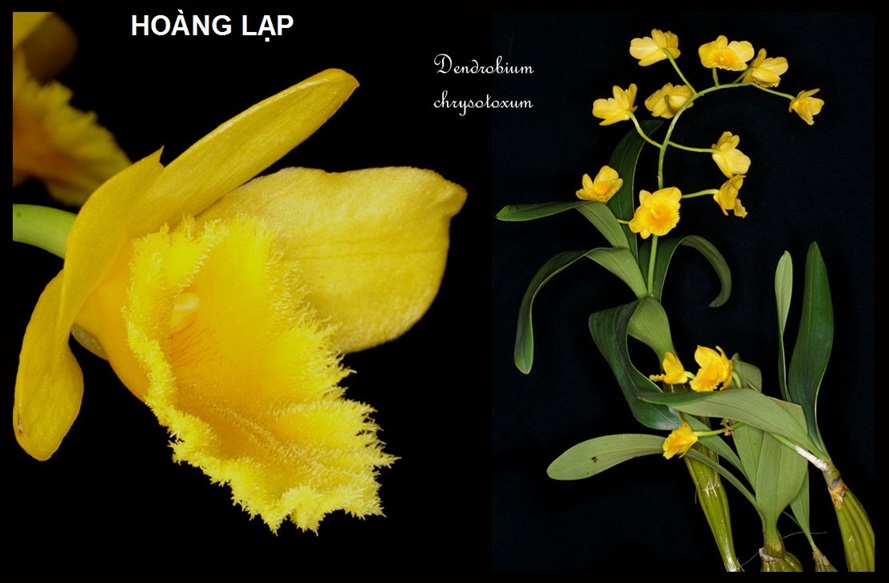
Dendrobium is a species of orchid belonging to the genus Dendrobium.
Dendrobium chrysotoxum, also known as Dendrobium chrysotoxum, is a genus of orchids native to Southeast Asia and South Asia, commonly distributed in the following countries:
- Vietnam: Lam Dong, Kon Tum, Gia Lai, Quang Nam and some provinces in the Northwest
- Laos, Thailand, Myanmar, India, China,...
Dendrobium orchids are epiphytic (living on large tree trunks) or lithophytic (living on moist rocks). They often appear at altitudes of 500 - 1500m, where the climate is tropical, subtropical and has a distinct difference between the dry season and the rainy season.
The name “chrysotoxum” is derived from Greek and means:
- Chrysos: Gold
- Toxon: Supply
→ Combined, it means “golden bow”, referring to the shape of the flower cluster curved like a golden bow.
What is special about Dendrobium orchid?
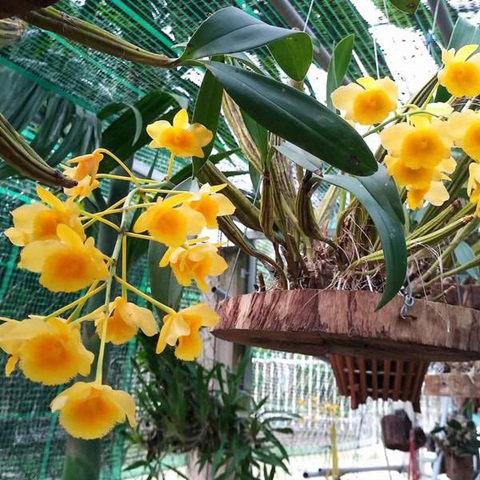
Close-up of flowers, stems and leaves of the orchid.
Below are the detailed characteristics of the shape of the orchid, including the stem, roots, leaves and flowers. Let's find out now to see what is outstanding and attractive about this orchid.
Close :
- Pseudobulb, swollen in the middle, straight or slightly curved, with longitudinal grooves
- Body length from 20 - 40 cm, diameter from 1.5 - 3 cm
- Young stems are turquoise, old stems turn yellow-brown.
- Each stem has only 2 - 7 leaves, concentrated at the top of the stem, the base has no leaves.
Roots :
- Wind roots, growing from the base of the trunk
- The roots are silvery white, the root tips are green.
Leaves :
- Leaves are simple, alternate, with leaf sheaths hugging the stem.
- Leaves are 7 - 19cm long and 2.5 - 3cm wide.
- Leaves are dark green, slightly shiny, tapered, soft
- Leaves usually fall in late autumn - early winter.
Flower :
- Flowers grow from old leafless stems, growing in curved clusters, each cluster has from 8 to 20 flowers.
- Flowers are 4 - 5 cm in diameter.
- The flowers are bright yellow, the throat of the flowers is orange or orange-yellow, looking very brilliant.
- Round, soft petals, slightly wavy edges
- Flowers have a pleasant, faint fragrance.
- Flowers bloom from February to May of the lunar calendar, late dry season - early rainy season
- Flowers bloom for about 7 - 10 days
Distinguishing between Dendrobium and Cymbidium orchids
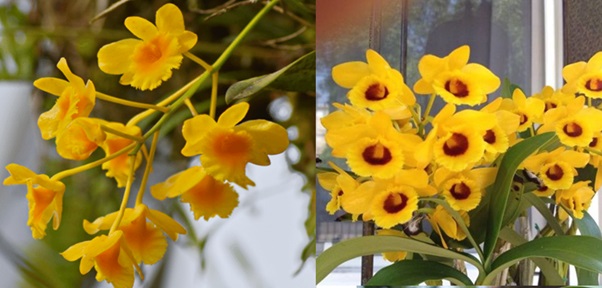
The difference in appearance between the Dendrobium orchid and the Cymbidium orchid..
Nowadays, many people confuse the orchid Hoang Lap and the orchid Son Thuy Tien because both of these flowers belong to the genus Hoang Thao and have quite similar colors. Right below, we will help you point out the differences between these two orchids so that you can distinguish them more easily.
|
Criteria |
Dendrobium Orchid |
Cymbidium orchid |
|
Overall flower color |
Bright yellow |
Orange yellow |
|
Flower lips (Flower throat) |
Bright orange, orange yellow |
Purple or dark brown |
|
Petal |
Round, shiny, slightly curved flower edges |
Petals are thinner, less wavy, not shiny |
|
Close |
pseudobulge |
pseudobulb, not much swollen |
|
Collectible value |
Popular, easy to grow |
Rarer, more expensive |
A-Z guide to caring for Dendrobium orchids

Detailed instructions for caring for Dendrobium orchids.
Right below is the most detailed guide to caring for Dendrobium orchids. If you want to own orchids with the brightest yellow color, don't miss it.
Choose healthy Dendrobium orchid varieties - plant in the right season
The first important thing you need to note is to choose a good variety of Dendrobium orchid and plant it at the right time to help the orchid pot grow best. Specifically as follows:
- Choose orchid seedlings with large pseudobulbs and clear dormant buds.
- The tree trunk is not crushed, no signs of pests or diseases
- The best time to plant orchids is from March to June, after the flowering season, before the rainy season.
- Do not plant Dendrobium orchids in the cold season or close to the flowering season because it will slow down the growth of the orchid and make the plant susceptible to decline.
Choose the right substrate - Clean treatment
After choosing the variety, you need to choose the appropriate substrate and process it carefully to proceed with planting/grafting the Dendrobium orchid.
- Conditions: The substrate must be airy, well-drained, and relatively moist.
- Suitable substrate: moss board, driftwood, charcoal, coconut fiber, pumice, pine bark,...
- Substrate treatment: Clean the substrate by soaking in lime solution or Physan 20 to remove fungus and insects.
Planting/grafting Dendrobium orchids with the right technique
When planting/grafting Dendrobium orchids into pots or wooden boards, you need to note the following:
- Fix the orchid roots firmly but avoid crushing the orchid stem.
- Rotate the dormant eyes outward so they can develop well, not burying the dormant eyes
- When planting in pots, place a layer of pumice at the bottom of the pot to help with better drainage.
- After planting, do not water immediately but wait 5-7 days before starting watering.
Ensure ideal light, temperature, and watering
To help the Dendrobium orchid grow best, you need to maintain proper light, temperature and watering.
- Temperature : Light from 60 - 70%, early morning sunlight or diffused light, avoid strong noon sunlight.
- Ventilation : The planting area needs to be airy, have light wind, and limit humidity.
- Watering : Keep the growing medium moist, watering frequency depends on the season, water every day in the dry season, reduce watering frequency in the rainy season.
Fertilize properly
There are many types of fertilizers that you can choose to fertilize Dendrobium orchids, depending on the conditions and growth stage. Here are some suitable suggestions:
- Fertilizer type : Organic fertilizer such as goat manure, decomposed cow manure, slow-release fertilizer, ryan, NPK,...
- Fertilization : In early spring, fertilize with nitrogen-rich fertilizer, in late spring, switch to low nitrogen, high potassium fertilizer, when the plant buds, stop fertilizing, after the flowers fade, fertilize with NPK rich in nitrogen and phosphate to help the plant recover.
Proactive pest control
Although the Dendrobium orchid is easy to domesticate and adapt, if the care conditions are not suitable, they can still get some common orchid diseases such as fungus, aphids, powdery mildew, etc.
Here are some proactive disease prevention measures, please refer to them now.
- Periodically spray pesticides to prevent fungal diseases, mealybugs, etc. such as: Physan 20 L, Ridomil Gol, Movento, etc.
- Observe the plant every day to detect unusual signs and then take timely action.
- Prune yellow leaves and damaged roots immediately to prevent the spread of disease.
- Maintain a clean, airy orchid growing environment
How to stimulate orchids to bloom
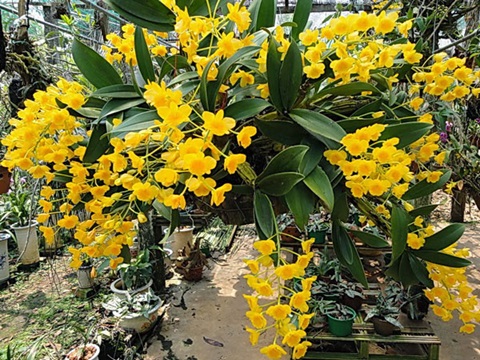
A beautiful blooming orchid.
To help the orchid bloom evenly, on time and with the most brilliant colors, you should stimulate flowering according to the instructions below.
Determine the time to stimulate flowering
Not at any age or time can the orchid bloom successfully because if the plant is young or the time is not suitable, the plant cannot bloom.
Suitable time :
- Late winter - early spring (December - February of the lunar calendar)
- After the tree has rested and stopped growing
Necessary conditions :
- The orchid is old and no longer develops new roots or leaves.
- The tree has lost its leaves, its trunk is tight, and it has dormant buds.
Create a hibernation phase
Before stimulating the flowering of the Dendrobium orchid, you need to create a "hibernation" state for them by doing the following:
- End of October - November of the lunar calendar, stop watering, only spray light mist 1 - 2 times/week
- Do not fertilize, hang orchids in a cool place
- After about 4 - 6 weeks of creating a dry environment, you will see flower eyes appear on the stem nodes.
Popular methods to stimulate orchid flowering
Let's refer to some effective methods of stimulating orchid flowers shared below to choose the most suitable method for you.
Stimulate orchids with water & temperature :
- Water thoroughly in the morning to “wake up” the plant after its “hibernation” period.
- Place the orchid pot in a cool place with a temperature difference between day and night of 5 - 8 degrees Celsius.
Stimulate orchids by using drugs :
- Use biological medicine: diluted B1 or Atonik 2ml/1 liter of water, spray on the tree trunk every 2 weeks.
- Specialized flower stimulant: Dekamon 22.43 L, Yogen according to recommended dosage
Flower care and nourishment
After stimulating flowers, you need to pay attention to flower care and maintenance, specifically as follows.
Adjust the light :
- Place the plant in a place with 60 - 70% diffused light in the early morning to help flower buds develop.
- At night, put the orchid in a cool place with a temperature of 15 - 18 degrees Celsius to maintain stable growth.
- Avoid strong winds and rain because they can damage the eyes.
Monitor and care for flowers :
- Add NPK 6-30-30 fertilizer to nourish buds
- Daily maintain misting for orchids, do not water directly on buds.
Orchid price list
If you want to buy a Dendrobium orchid to decorate your garden, please refer to the detailed price list shared here. Because this orchid is currently sold at many different prices, depending on the origin, purity and age of the orchid.
|
Orchid species |
Characteristic |
Reference price (VND) |
|
Wild Dendrobium Orchid - whole lot |
Naturally harvested from the forest, uncultivated, sold by kg |
220,000 - 270,000 VND/kg |
|
Wild Dendrobium orchid has been domesticated in the garden |
Original, fat body |
100,000 - 150,000 VND/tree |
|
Dendrobium orchid - Goods exploited from Laos |
Sold by kg, forest standard |
170,000 - 250,000 VND/kg |
|
Dendrobium Orchid |
Sell flower branches or young plants |
45,000 - 60,000 VND/200g |
Questions and answers about Dendrobium orchid
What month does the orchid bloom?
Normally, the orchid usually blooms around February - May of the lunar calendar (end of dry season - beginning of rainy season).
Are Dendrobium orchids fragrant?
Dendrobium orchids have a light, pleasant fragrance. If grown in an open environment, the scent will spread very well.
Is Dendrobium difficult to grow?
No, Dendrobium orchids are very easy to grow, easy to domesticate, and adaptable to many different substrates and environments.
Does Dendrobium like sun?
Dendrobium orchids only like light, bright sunlight and cannot stand strong midday sun. Maintaining diffused light of about 60 - 70% is most suitable.
Beautiful Dendrobium Orchid Pictures
We invite you to admire the orchid pots showing off their bright yellow color that we have collected below to feel the impressive beauty of this orchid species of the genus Dendrobium.

A giant pot of Dendrobium orchid is blooming beautifully.
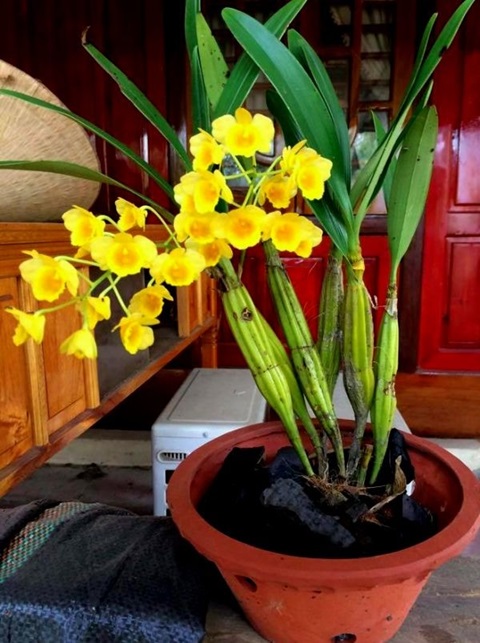
The flowers of the Dendrobium orchid are a brilliant bright yellow.
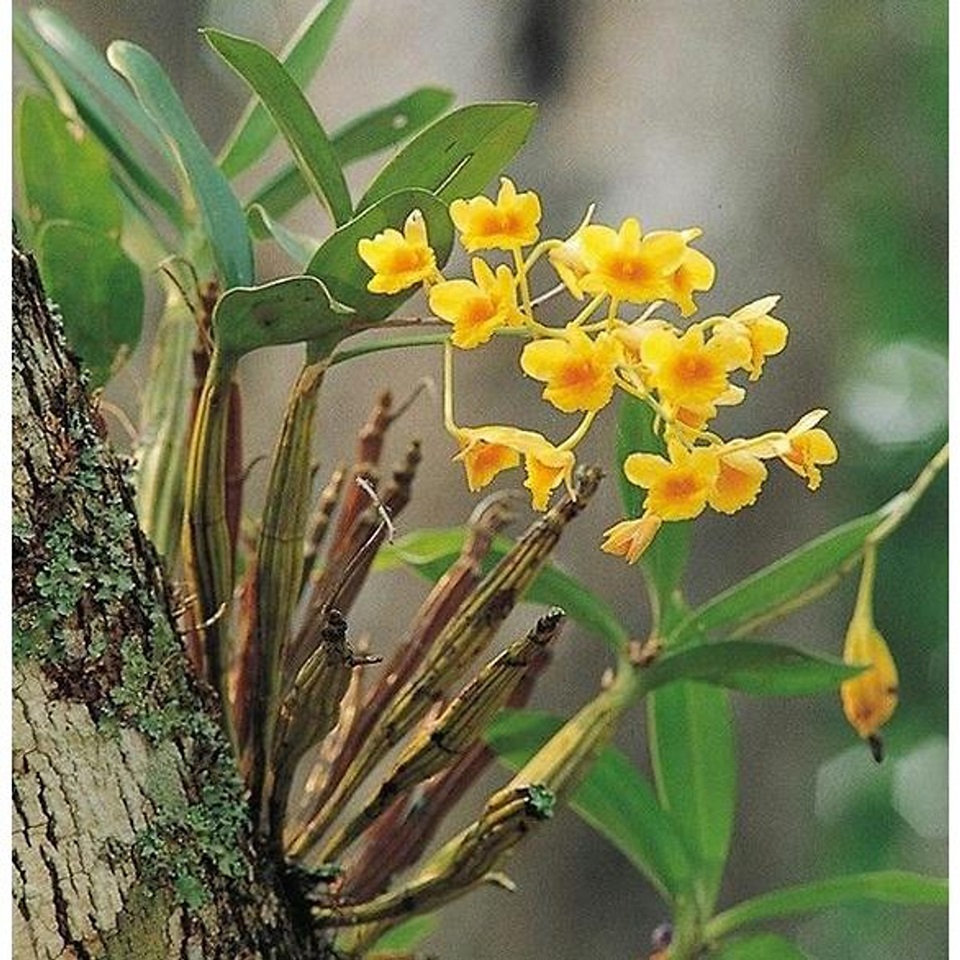
Image of wild Dendrobium orchid growing epiphytically on a tree trunk.
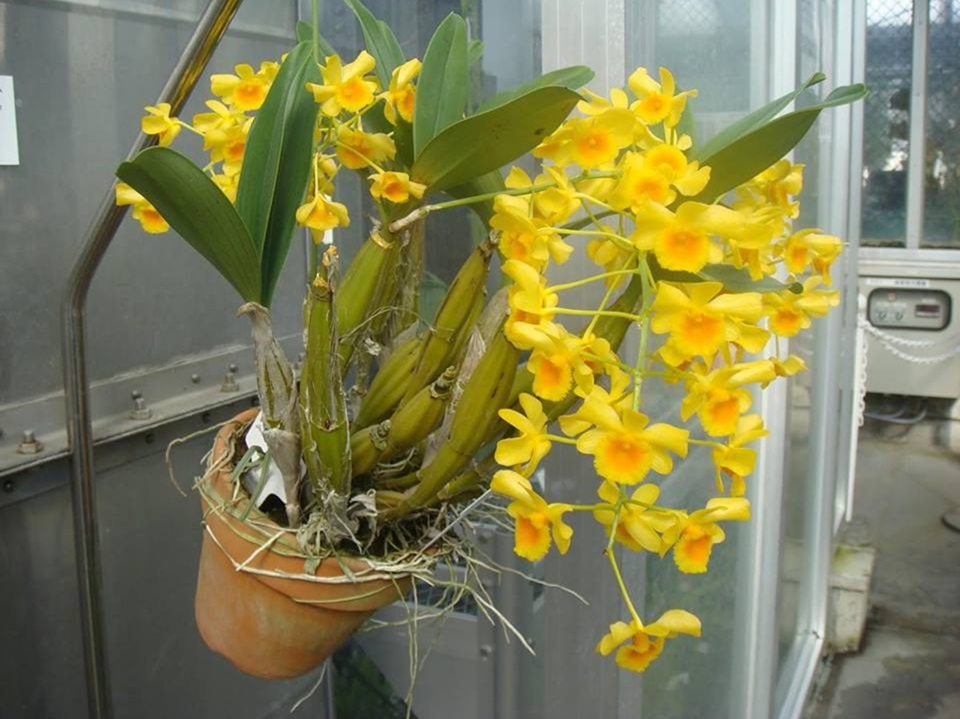
Orchid pot with bright yellow flowers.
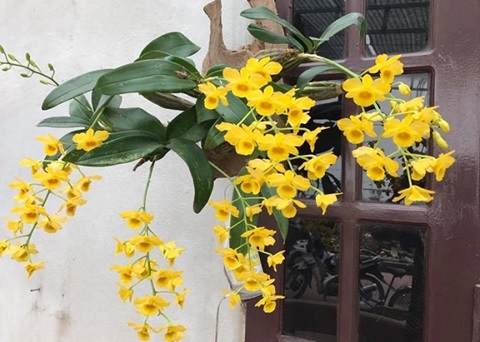
A simple but very outstanding orchid pot.
With outstanding colors, beautiful flower shapes and good adaptability, the Dendrobium orchid is a perfect choice for those new to orchid growing or those who like to collect beautiful orchids.
Hopefully, the information that orchid-vn.com shares above will help you understand and master the techniques of planting and caring for this orchid species. If you want to discover more beautiful wild orchids and hybrid orchids, please visit our Blog section now so you don't miss any articles.
